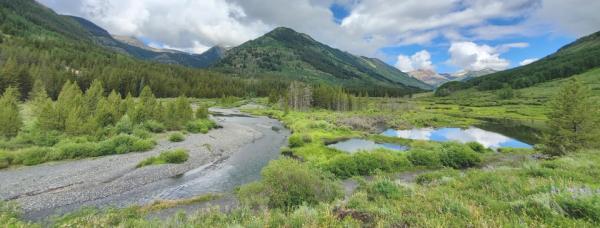Slate River Field Site
Slate River
Crested Butte, Colorado, USA
The scenic, glacial-carved mountain headwaters of Crested Butte, CO make for an ideal location to study floodplain biogeochemistry. Expansive reaches of floodplain with a history of anthropogenic influence provide the arena for our team to investigate groundwater chemistry and subsurface exchange.

Our primary field site is located on the Slate River floodplain 1.6 km NW of the town of Crested Butte, CO. Situated directly downstream of the Oh-Be-Joyful Creek confluence, our study site experiences an array of biotic and abiotic drivers that are characteristic of many mountainous systems in the Western United States.
Snowmelt Dynamics
The transition from mountaintop snow to river channel flow is far from simple. Long-term patterns in snowfall govern river flow and subsequent water availability in the floodplain.

Anthropogenic History
Like in many regions of the West, the Slate River has a storied history of coal and heavy metal mining.

Beaver Influence
The riverscape of the Slate River Valley is heavily influenced by the presence of beaver - altering the extent of wetlands, lateral flow of water, and a vast suite of biogeochemical dynamics.

INSTRUMENTATION & INFRASTRUCTURE
Piezometric Wells & Rhizon Samplers

We have installed an extensive network of specially-built wells and samplers across our study floodplain to extract highly sensitive pore waters without the generation of redox artifacts. Preserving sample redox state is essential for analyzing the structure of colloidal nanoparticles.
Water Table & Vertical Hydraulic Gradient Monitoring

In addition to our network of water quality wells is a paralleled mesh of water level sensors, monitoring seasonal variability in water table elevation and direction of hydraulic gradient across the gravel interface.
Meteorological Station & Remote Sensing

Complementing our sampling infrastructure, our met station provides a continuous flow of atmospheric and subsurface data, fueling the development of predictive reactive transport models.
